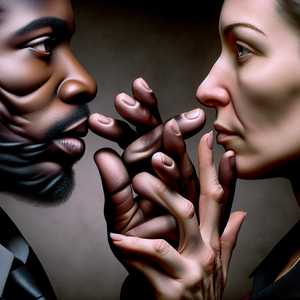The Hidden Skills That Set Top UI/UX Developers Apart

UI/UX design is fundamentally about understanding users and creating experiences that resonate with them. In this context, soft skills play a pivotal role in the success of a UI/UX developer. Unlike hard skills, which can be easily measured and quantified, soft skills are subtler and often overlooked. However, they are crucial for creating designs that genuinely connect with users. Below are three hidden skills that can significantly enhance a UI/UX developer’s effectiveness.
1. Storytelling
At its core, UI/UX design is about communicating a narrative through visual elements and user interactions. Storytelling enables developers to present their designs in a way that captures emotions and engages users. By crafting a narrative around the user journey, designers can create more compelling experiences that resonate on a personal level. Example: Consider a mobile health app designed for chronic illness management. A developer who utilizes storytelling can create scenarios that depict users' struggles and victories, making the app not just a tool but a companion in their health journey. For instance, the app could feature a user story that highlights the challenges faced by someone managing a chronic condition, showcasing how the app provides support and solutions. This narrative approach not only enhances user engagement but also fosters loyalty and trust in the product.
2. Empathy Mapping
Empathy is a cornerstone of user-centered design. The ability to understand and anticipate the needs, motivations, and pain points of users is invaluable. Empathy mapping is a technique that allows developers to visualize user experiences and feelings, thus informing design decisions. Example: A UI/UX developer working on an e-commerce platform could employ empathy mapping to identify why users abandon their carts. By understanding the anxiety or frustration users experience during the checkout process—such as unexpected shipping costs or complex forms—developers can implement design changes that alleviate these concerns, ultimately leading to higher conversion rates. This empathetic approach ensures that the final product is tailored to meet users' real needs and expectations.
3. Adaptability
In the fast-paced world of technology, adaptability is essential. UI/UX developers must be prepared to pivot their designs and strategies in response to emerging trends, user feedback, and technological advancements. This flexibility allows them to stay relevant and meet changing user expectations. Example: During the COVID-19 pandemic, many businesses had to rapidly shift to digital platforms. UI/UX developers who could adapt their designs to accommodate remote work, social distancing measures, and changing user behaviors found success in creating products that met new demands. For instance, a developer might redesign a restaurant’s app to include contactless ordering and payment features, ensuring that users feel safe and comfortable. Their ability to stay agile not only benefited their clients but also enhanced their professional reputation in an ever-evolving landscape.
Building a Unique Skill Set
To cultivate these hidden skills, aspiring UI/UX developers can take several actionable steps: - Practice Storytelling: Engage in workshops that focus on narrative-building or take courses in creative writing. This practice can help you articulate your design ideas more compellingly and connect with users on an emotional level. - Learn Empathy Mapping: Collaborate with user research teams or participate in user interviews to better understand the audience. Utilizing tools like empathy maps can facilitate deeper insights into user experiences, ultimately guiding design decisions. - Enhance Adaptability: Stay informed about industry trends by following thought leaders, attending webinars, and participating in design hackathons. The more exposure you have to different perspectives and methodologies, the more adaptable you will become in your approach to design.
In conclusion, while technical skills are undeniably important in the realm of UI/UX development, it is the hidden skills—storytelling, empathy mapping, and adaptability—that can truly set a developer apart in a crowded job market. By honing these abilities, UI/UX developers can create user-centered designs that not only meet functional requirements but also engage users on a deeper emotional level. As the industry continues to evolve, those who cultivate these hidden talents will undoubtedly find themselves at the forefront of design innovation, shaping the future of user experiences. In a competitive environment, it is these unique skills that will not only ensure career advancement but also lead to the creation of impactful, meaningful designs that resonate with users.
UI/UX Researcher
Google, Microsoft, Amazon
Core Responsibilities
Conduct user interviews and usability testing to gather insights on user behavior and preferences.
Analyze qualitative and quantitative data to inform design decisions and improve user experiences.
Collaborate with design and product teams to create user personas and journey maps.
Required Skills
Proficiency in research methodologies, including surveys, A/B testing, and contextual inquiries.
Strong analytical skills to interpret data and generate actionable insights.
Familiarity with user research tools such as UserTesting, Optimal Workshop, or Lookback.
Common Employers
Companies like Google, Microsoft, and Amazon often seek UI/UX Researchers to enhance their product offerings.
Interaction Designer
Facebook, Adobe, Airbnb
Core Responsibilities
Design and prototype interactive elements of web and mobile applications, focusing on enhancing user engagement.
Create wireframes, mockups, and interactive prototypes to communicate design concepts effectively.
Collaborate with developers to ensure design feasibility and maintain design consistency across platforms.
Required Skills
Proficiency in design tools such as Sketch, Figma, or Adobe XD.
Understanding of user-centered design principles and interaction design best practices.
Strong communication skills for presenting ideas and collaborating with cross-functional teams.
Common Employers
Startups and tech giants like Facebook, Adobe, and Airbnb often hire Interaction Designers to create intuitive user interfaces.
Visual Designer
Spotify, Netflix, Slack
Core Responsibilities
Develop and maintain the visual identity of digital products, ensuring that design elements align with brand guidelines.
Create high-fidelity designs and graphics that enhance the overall user experience.
Collaborate with UX designers and developers to bring concepts to life while maintaining aesthetic integrity.
Required Skills
Expertise in graphic design software such as Adobe Creative Suite (Photoshop, Illustrator) and prototyping tools.
Strong understanding of typography, color theory, and layout design.
Ability to work under tight deadlines while maintaining attention to detail.
Common Employers
Companies like Spotify, Netflix, and Slack frequently look for Visual Designers to enhance their digital presence.
Product Designer
Shopify, Dropbox, LinkedIn
Core Responsibilities
Oversee the entire design process from concept to implementation, ensuring that products meet user needs and business goals.
Conduct competitive analysis and market research to identify opportunities for product improvement.
Collaborate with engineers and product managers to balance user needs with technical feasibility.
Required Skills
Strong portfolio showcasing a range of projects that demonstrate design thinking and problem-solving skills.
Familiarity with Agile methodologies and experience working in fast-paced environments.
Proficiency in both UI and UX design principles, with a solid understanding of front-end development.
Common Employers
Tech companies such as Shopify, Dropbox, and LinkedIn often seek Product Designers to lead design initiatives.
UX Writer
Twitter, Airbnb, HubSpot
Core Responsibilities
Craft clear, concise, and engaging copy for user interfaces, including buttons, menus, and error messages.
Collaborate with designers and product teams to ensure that the language aligns with the overall user experience.
Conduct user testing on copy and iterate based on feedback to improve clarity and engagement.
Required Skills
Excellent writing and editing skills with a focus on user-centered communication.
Understanding of UX design principles and how language impacts user experience.
Familiarity with content management systems and basic HTML/CSS can be a plus.
Common Employers
Organizations like Twitter, Airbnb, and HubSpot actively hire UX Writers to enhance their product narratives.


